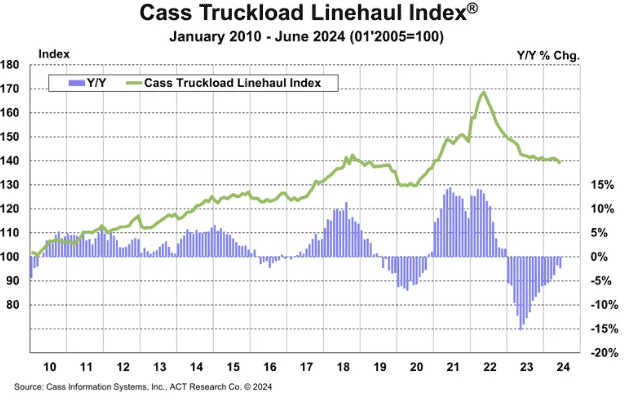As part of our usual review of each half year in supply chain, I recently took a look at the top stories by month in 1H
2024 (see The Top Supply Chain Stories by Month 1H 2024.).
This week, we offer our popular look at the first six months of 2024 in numbers and charts.
Gilmore Says.... |
 US ecommerce sales were up 8.6% versus 2023, above the overall US retail sales growth of just 1.5%. US ecommerce sales were up 8.6% versus 2023, above the overall US retail sales growth of just 1.5%.
. |
What do you say? |
|
| Click here to send us your comments |
|
|
We always start with a check on the US and global economy, as that has such an impact in the end on supply chain practice.
In Q1 we saw real GDP growth of a weak 1.4%, down from 3.4% in Q4 2023. But in numbers released just yesterday, Q2 GDP growth was a solid 2.8%, according to the first estimate from the Commerce Dept.
Just recently the International Monetary Fund (IMF) kept its 2024 global real gross domestic product growth forecast unchanged from April at 3.2% and raised its 2025 forecast by 0.1 percentage point to 3.3%. Both are low by historical standards.
The IMF forecast US GDP at 2.6% growth for 2024, compared to 5.0% for China.
One measure of the health of the US manufacturing sector is the US Purchasing Managers Index from the Institute of Supply Management. As shown below, the PMI has been below the key 50 mark that separates US manufacturing expansion from contraction for 11 out of 12 months, and indeed it has been 19 out of the last 20 months underwater.

Source: ISM
So mixed signals on the economy, with weak but positive Q1 GDP, then better in Q2, but the PMI indicating a prolonged manufacturing slump.
Another view of US manufacturing strength is the index on US factory output from the Federal Reserve.
The index for June came out at 100.3, making it the fourth straight month of an increase, showing some strength after flatness for many months. However, the June score is still well below the 105 level in February 2020 right before the COVID crisis.
In fact, at index level of 100.3, it means US manufacturing output is barely above the baseline year of 2017 levels (index = 100) now seven long years later.
It was an up six months for oil prices in the first half of the year. At the start of January crude was $71.65 per barrel, and it went mostly up from there, ending June at $81.34, for a rise of 13.8% (but falling in July). The high in the 1H was $86.91 in early April.

US on-the-road diesel prices were flat, which started the year at $3.87 per gallon, and ending in June at $3.81, with a peak of $4.10 in February.
Freight volumes were mixed. The Freight Tonnage Index from ATA for June was down a slight 0.4% versus 2023. In May, the index was up 1% from a year earlier, which was the first year-over-year gain since February 2023. The full index reading for June was 113.5, versus the baseline of the average month in 2015 (index = 100), meaning nine years later US freight tonnage is only up 13.5%.
The Cass Linehaul Index, which tracks per mile truckload contract rates in the US before any fuel surcharge or other accessorial fees, has been down year-over-year since mid-2022, as seen in the chart below. The index is now almost back to mid-2020 rate levels.'

Source: Cass Info
It was a decent first half for US railroads. Total combined US carload and intermodal traffic for 1H 2024 was 12.2 million, an increase of 2.2% compared to 1H 2023. Carloads were down 4.5%, while intermodal cars were up 8.7%.
Ocean container shipping rates soared after so-call Houthi-rebels started firing missiles at cargo ships and forced carriers to abandon sailing through the Red Sea and Suez Canal, taking the long way around southern Africa instead. Rates from China to the US East Coast have soared to almost $10,000 by end of June, nearly double the cost in February.
The growth of ecommerce reversed a recent flat trend in Q1, the most recent number we have. US ecommerce sales were up 8.6% versus 2023, above the overall US retail sales growth of just 1.5%. eCommerce sales as a share of total retail rose to 15.9%, by the way the Census Bureau measures it, up from 14.9% in Q1 2023.
I have lots more but am out of space. Hope you enjoyed all this.
What is your reaction of 1H supply chain 2024 in numbers and charts? What numbers would you add? Let us know your thought at the Feedback section below.
Your Comments/Feedback
|